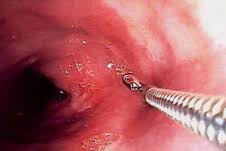
In medical practice, Endoscopy is the act of observing inside the body for the purposes of diagnosis or treatment performed by a device called Endoscope. The cavities and paths in the body allow the medical examination of the inner parts of body. Endoscopy is based on a mirror and the reflected light. To see covering the esophagus (esophageal) and gastric endoscopy, doctors pass a thick pipe through patient's esophagus, which is annoying for many of them. Endoscopic tests are the most accurate and helpful ways to investigate the causes of digestive problems, especially the gastric ones. This test is the best way to diagnose peptic ulcers and gastric cancer, and also very useful for the diagnosis of Helicobacter pylori infection.
Endoscope is a tool for the examination of Intraluminal and cavities of the body. This device is tubular and there is tubular and contains a light source, mirror and often a camera and biopsy tool. Conventionally, endoscope is a device that enters the stomach through esophagus in order to observe the upper parts of gastrointestinal tract. Endoscope is sometimes used for other applications such as sampling, removing polyps, hemorrhagic arteries cautery and even laser tumors.
In most cases, doctors use endoscopy in patients to check the following problems:
- Stomachache
- stomach ulcers, gastritis, or difficulty in swallowing food
- Gastrointestinal Bleeding
- altered bowel habits (constipation or diarrhea)
- Colon polyps
During the endoscopy, should be comfortable and lie down on your left. Numbing spray is used on your throat to not feel anything. There is also a small protecting part placed in between your teeth. This will preserve your teeth and the endoscope from damage. When you're ready, the doctor puts the endoscope on your tongue and asks you to swallow it. By doing this, the esophagus is opened and endoscope enters it and goes to the stomach.
 English
English فارسی
فارسی